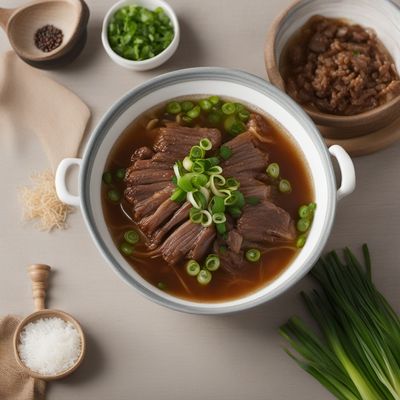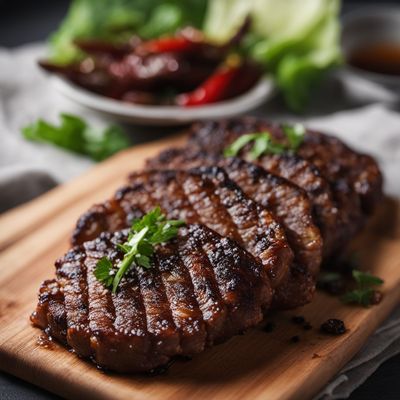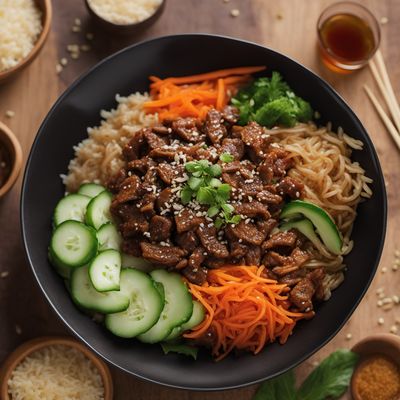
Recipe
Refreshing Korean Vegetable Salad
Crisp and Colorful Saengchae: A Burst of Freshness
4.8 out of 5
Saengchae is a traditional Korean vegetable salad that showcases the vibrant flavors and textures of fresh vegetables. This light and refreshing dish is a staple in Korean cuisine, often served as a side dish or a topping for grilled meats.
Metadata
Preparation time
20 minutes
Cooking time
N/A
Total time
20 minutes
Yields
4 servings
Preparation difficulty
Easy
Suitable for
Vegetarian, Vegan, Gluten-free, Dairy-free, Low calorie
Allergens
Sesame
Not suitable for
Paleo, Keto, Nut-free, Soy-free, High protein
Ingredients
-
1 cucumber, julienned 1 cucumber, julienned
-
1 carrot, julienned 1 carrot, julienned
-
1 small daikon radish, julienned 1 small daikon radish, julienned
-
4 cups lettuce, thinly sliced 4 cups lettuce, thinly sliced
-
2 tablespoons soy sauce 2 tablespoons soy sauce
-
2 tablespoons rice vinegar 2 tablespoons rice vinegar
-
1 tablespoon sesame oil 1 tablespoon sesame oil
-
2 cloves garlic, minced 2 cloves garlic, minced
-
1 teaspoon chili flakes (gochugaru) 1 teaspoon chili flakes (gochugaru)
-
1 tablespoon sesame seeds, for garnish 1 tablespoon sesame seeds, for garnish
-
Salt, to taste Salt, to taste
Nutrition
- Calories (kcal / KJ): 70 kcal / 293 KJ
- Fat (total, saturated): 4g, 0.5g
- Carbohydrates (total, sugars): 8g, 3g
- Protein: 2g
- Fiber: 2g
- Salt: 1g
Preparation
-
1.In a large bowl, combine the cucumber, carrot, radish, and lettuce.
-
2.In a separate small bowl, whisk together the soy sauce, rice vinegar, sesame oil, minced garlic, chili flakes, and a pinch of salt.
-
3.Pour the dressing over the vegetables and toss well to coat evenly.
-
4.Let the salad marinate for at least 15 minutes to allow the flavors to meld together.
-
5.Sprinkle sesame seeds on top for garnish.
-
6.Serve chilled and enjoy!
Treat your ingredients with care...
- Cucumber — Remove the seeds before julienning to prevent excess moisture in the salad.
- Carrot — Use a julienne peeler or a mandoline slicer for thin and uniform strips.
- Radish — If daikon radish is not available, regular radishes can be used as a substitute.
- Lettuce — Opt for crisp lettuce varieties like romaine or iceberg for the best texture.
- Sesame seeds — Toast the sesame seeds in a dry pan over medium heat for a few minutes until fragrant before garnishing the salad.
Tips & Tricks
- For a spicier kick, increase the amount of chili flakes according to your preference.
- Add a splash of fresh lime juice for an extra burst of citrus flavor.
- To make it a heartier meal, top the salad with grilled chicken or tofu.
- Experiment with different vegetables like bell peppers or bean sprouts to personalize the salad.
- Make sure to slice the vegetables thinly and uniformly for a visually appealing presentation.
Serving advice
Serve Saengchae as a side dish alongside Korean BBQ or as a refreshing topping for bibimbap. It pairs well with steamed rice and can also be enjoyed on its own as a light and healthy snack.
Presentation advice
Arrange the colorful julienned vegetables in a mound on a serving platter, and drizzle the dressing over the top. Sprinkle sesame seeds as a garnish for an added touch of elegance. The vibrant colors and fresh ingredients will make the salad visually appealing and appetizing.
More recipes...
For Korean cuisine » Browse all
More Korean cuisine dishes » Browse all

Dasik
Dasik is a traditional Korean dessert made from various grains, nuts, and sweeteners. It has a crunchy texture and a sweet, nutty flavor.

Samgyeopsal
Grilled Pork Belly
Samgyeopsal is a traditional Korean dish that consists of grilled pork belly slices served with various condiments.

Tutmaji
Sweet potato soup
Tutmaji is a traditional dish from the West African country of Mali. It is a hearty stew made with chicken, vegetables, and rice. The dish is...






